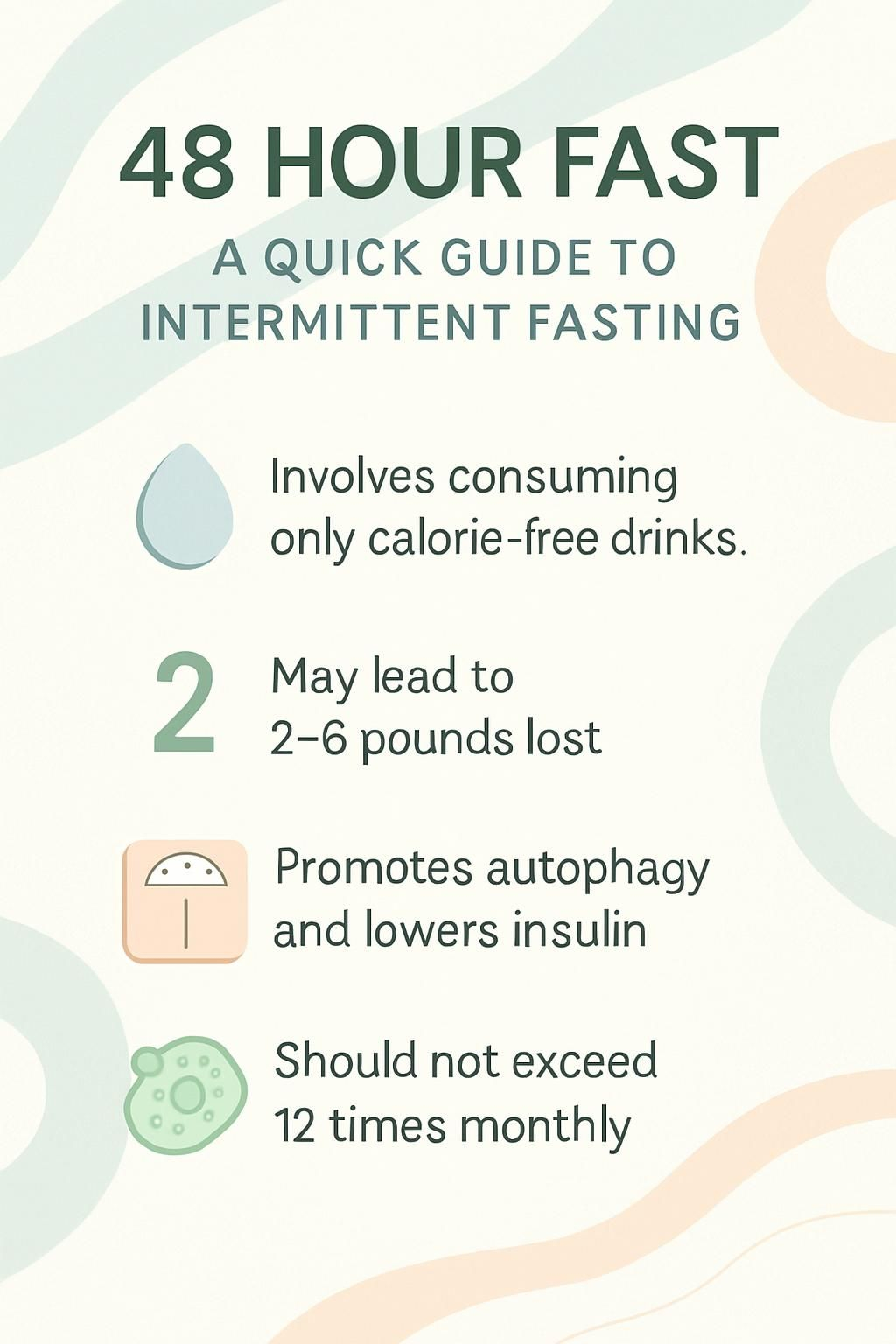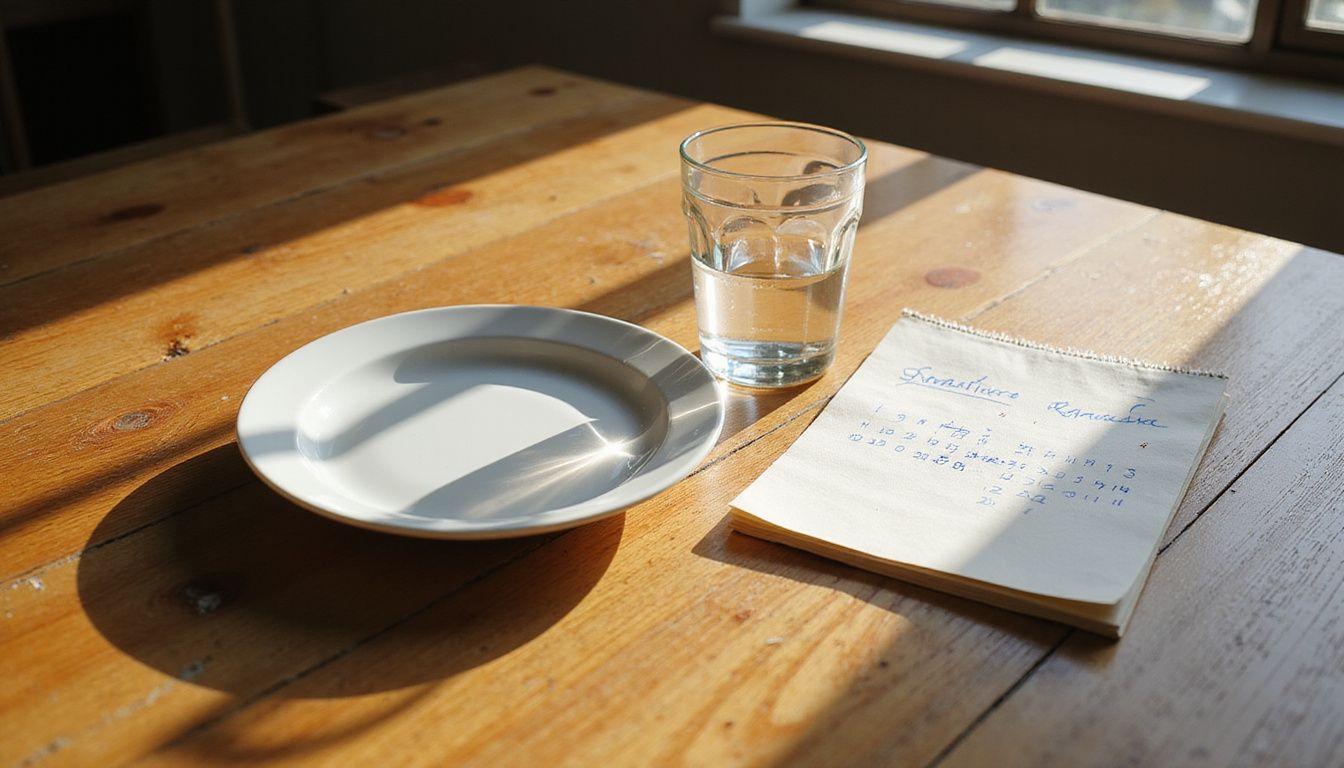48 Hour Fast: A Quick Guide To Intermittent Fasting
Our Nutrition Assistant AI Suite will transform your body. You will lose fat, get toned, and build muscle. Gain confidence and optimal health.
If constant hunger, cravings, or weight gain wear you down, a 48-hour fast could give you a clean reset. This type of intermittent fasting means two full days without food while you drink only zero-calorie liquids like water, black coffee, or unsweetened tea. Used with care, it can support weight loss, insulin control, and better energy.
This quick guide explains how a 48-hour fast works, the key health benefits, and the safest way to try it. Curious whether this approach fits your goals and routine? Keep reading to learn what to know about 48-hour fasting before you start.
Key Takeaways
- A 48-hour fast limits intake to calorie-free drinks for two days and may drop 2–6 pounds quickly, mostly from water and glycogen, not pure fat.
- Peer-reviewed research, including Longo and Panda 2016 and Trepanowski et al. 2017, links longer fasts with autophagy, lower insulin, better insulin sensitivity, and cell repair.
- Common effects include hunger, dizziness, and fatigue. Hydration and electrolytes reduce these issues in most people.
- Fasts beyond 24 hours may sharpen mental clarity and lower some inflammation markers. They can also disrupt social plans and should be limited to no more than 12 per month.
- Experts suggest starting with shorter fasts, easing into longer windows, avoiding heavy exercise, and checking with your clinician if you use medication or manage a chronic condition.

What Is a 48-Hour Fast and How Does It Work?

A 48-hour fast is a planned period of two days without food. You drink only non-caloric fluids, such as water, black coffee, or unsweetened tea. Many people use this form of intermittent fasting to cut calories, support fat loss, and improve metabolic health.
What Defines a 48-Hour Fast?
During a 48-hour fast, you avoid all foods and stick to calorie-free drinks for two full days. A common schedule starts after dinner on day one, continues through the next two calendar days, then you begin eating again at dinner on day three.
This is one of the longest fasting windows people practice regularly. You still get 10 to 12 hours of overnight fasting within each day of the window, which adds to the total time without food. On your non-fasting days, aim for a balanced, healthy diet and avoid rebound overeating.
Some experienced fasters repeat this protocol up to 12 times per month with enough space between fasts. The goal is to support fat loss, improve insulin sensitivity, and encourage cellular clean-up without burning out your routine.
Fasting for 48 hours can help your body switch from burning glucose to burning fat, which may support weight loss and promote cellular repair.
How Does It Compare to Other Intermittent Fasting Methods?
Longer fasts work differently than daily patterns like 16:8 or alternate-day fasting. The table below compares common methods, including typical benefits and challenges.
| Fasting Method | Duration | Frequency | Potential Benefits | Common Challenges | Best For |
|---|---|---|---|---|---|
| 16:8 Method | 16 hours fasting, 8 hours eating | Daily |
|
| Beginners and daily routines |
| Alternate-Day Fasting | 24 hours fasting, 24 hours eating | 3-4 times weekly |
|
| Intermediate fasters, focused weight loss |
| 48-Hour Fast | 48 hours fasting | Up to 12 times per month |
|
| Experienced fasters who prefer less frequent fasts |
- Start with shorter fasts like 16:8 or alternate-day plans to build metabolic flexibility before you try longer windows.
- Limit 48-hour fasts to 12 per month to protect social time and recovery.
- Studies show most fasting styles reduce insulin and improve sensitivity, which supports metabolic health.
Personal Application: Many people begin with 16:8 and notice better energy and less snacking. After easing into a 48-hour fast, expect stronger hunger, a leaner look from water loss, and often clearer focus. Planning, sleep, and hydration make extended fasts far easier.
How to Do a 48-Hour Fast Safely
A 48-hour water fast challenges both body and mind. Good planning reduces risk, keeps blood sugar steadier, and makes the experience more manageable.
How Should You Prepare Your Body for a 48-Hour Fast?
Preparation lowers the odds of dizziness, poor sleep, and low energy. Use the checklist below a few days before your fast.
- Build up with shorter windows first, such as 16:8, so your body learns to run on fewer calories.
- Get at least 8 hours of sleep the night before you start. Research protocols often require it.
- Avoid alcohol and antihistamines for 48 hours pre-fast. Limit caffeine if it upsets your stomach.
- Skip heavy workouts for 24 hours before the start. Intense training drains glycogen and can raise fatigue.
- Eat nutrient-dense meals pre-fast. Include lean protein, healthy fats, whole grains, and vegetables to improve fullness.
- Hydrate well the day prior. Plan zero-calorie drinks that support electrolyte balance.
- Speak with your clinician if you take blood thinners, diabetes medicine, or blood pressure drugs. Some doses may need changes.
- Plan simple foods for refeeding. A gentle reintroduction prevents stomach upset and bloating.
- Tell a friend or family member. Support helps if you feel weak or lightheaded.
- Reduce life stress where possible. High stress can make fasting symptoms feel worse.
- Review peer-reviewed guides or university lectures online. Know both the benefits and risks of extended energy restriction.
What Can You Consume During a 48-Hour Fast?
Only zero-calorie drinks keep the fast intact. The goal is hydration without raising insulin or breaking the metabolic switch.
- Drink plenty of plain water to avoid dehydration. It supports healthy blood pressure and heart rate.
- Choose black coffee without milk or sweeteners. It may ease hunger and support alertness.
- Have unsweetened green tea or herbal tea. Green tea provides antioxidants with no added sugar.
- Use plain or flavored sparkling water with no sweeteners for variety.
- Add electrolytes if you feel dizzy. A pinch of salt in water or an electrolyte tablet can help.
- Avoid any calories from juice, soda, creamer, or protein supplements. These break the fast.
- Skip bone broth unless advised by a clinician. Even small calories end fasting benefits.
During my first 48-hour fast, cold sparkling water helped with cravings on day one. That simple habit made the window feel more doable and kept my mind clear.
How Do You End a 48-Hour Fast Safely?
Refeeding gently protects your stomach and keeps blood sugar from spiking. Take it slow for the first few hours.
- Start with a light snack such as a handful of almonds or a small yogurt.
- Wait 1–2 hours, then eat a small meal of easy foods like steamed vegetables, eggs, or broth.
- Avoid heavy, spicy, or ultra-processed foods at first. They often cause discomfort.
- Sip water as you eat to support digestion and hydration.
- Stop and eat if severe dizziness, diarrhea, or palpitations appear. Safety first.
- Return to regular meals the next day, but keep portions modest at first.
- Focus on nutrient-dense foods with lean protein, whole grains, and healthy fats to replenish energy.
- Delay intense workouts until after at least one full meal. Give your nervous system time to settle.
- If you use blood thinners, insulin, or have diabetes, check with your clinician about timing and dosing.
- Learning with shorter fasts first makes refeeding easier and more comfortable.
In short, end the fast with care, rebuild slowly, and watch for symptoms. Whole foods and steady hydration support a smooth recovery.
What Are the Benefits of a 48-Hour Fast?
A 48-hour fast may help with weight management and metabolic health. Many studies link extended fasting windows to better blood markers and cellular clean-up.
How Does a 48-Hour Fast Promote Autophagy and Cellular Repair?
Autophagy is the body’s recycling system. Cells break down worn parts and reuse what they can. Longer fasts, often 24 to 48 hours, can nudge this process to increase.
A 2019 pilot study found a surge in dozens of helpful metabolites after about 58 hours without food. These shifts may support muscle maintenance and antioxidant activity, which protect cells as you age.
People often report feeling mentally lighter during longer fasts. Less digestion can mean more energy for repair, which may also calm some inflammation signals.
Can a 48-Hour Fast Help with Weight Loss?
Skipping food for two days creates a large calorie gap, so short-term weight loss is common. Most early pounds come from water and stored glycogen, not just body fat.
Results depend on your size, diet, and activity level. If you return to old eating patterns, much of the weight can come back.
A 2025 systematic review reported that intermittent fasting, including 48-hour windows, does not beat simple calorie restriction for long-term weight loss. Lasting progress comes from daily habits and a plan you can keep.
How Does It Improve Insulin Sensitivity and Blood Sugar?
During a 48-hour fast, insulin drops as glycogen stores decline. That shift helps fat cells release stored energy and can improve insulin sensitivity, which is how well your cells respond to insulin.
Several studies show that longer fasting windows can even out blood sugar by reducing frequent spikes. Hormones linked to better glucose control, such as adiponectin, may rise with energy restriction.
Many people find weight control easier when insulin and hunger swings calm down. This is one reason extended fasting can feel different from standard dieting.
Does a 48-Hour Fast Reduce Inflammation?
Some research suggests extended fasts can lower certain inflammation markers tied to chronic disease. Less oxidative stress and fewer activated immune signals may protect tissues during the fast.
People who fast often notice mild joint relief or less morning stiffness for a day or two. Responses vary widely, so track how you feel and what lasts for you.
Can Fasting Boost Mental Clarity and Focus?
Some notice sharper focus on longer fasts. In one 2016 study of amateur lifters, reaction times improved after 48 hours without food. The brain also showed signs of using less energy while still performing well.
Better insulin control and fewer glucose swings may help clear mental fog. If focus is one of your goals, intermittent fasting could offer cognitive benefits as a bonus.
What Challenges Might You Face During a 48-Hour Fast?
Extended fasting tests your body and your routine. Planning and the right mindset reduce most friction.
How to Manage Hunger and Dizziness?
Hunger and lightheaded spells are common, especially for first-timers. A few simple habits can help a lot.
- Drink water or other zero-calorie drinks often to reduce hunger and dizziness.
- Add small amounts of sodium, potassium, and magnesium if needed. Electrolytes support balance.
- Rest as much as you can. Avoid heavy workouts in the first 24 hours.
- End the fast if you feel faint or very ill. Side effects are common during long fasts.
- Stay busy with low-effort tasks, reading, or light walks to take your mind off hunger.
- Practice slow, deep breathing if you feel woozy. Calm breathing helps ease the moment.
- Warm herbal tea helped me most during long windows. A simple ritual can make a big difference.
- Ask friends for support during meals and events. A plan lowers social pressure.
With practice and prep, most symptoms improve. Ease in with shorter fasts to build confidence.
How to Cope with Exhaustion and Sluggishness?
Low energy shows up for many people in long fasts. Carbohydrate stores run low, so plan for a slower pace.
- Drink water often. Dehydration makes fatigue worse.
- Add a pinch of salt or use a low-calorie electrolyte. It can reduce dizziness and weakness.
- Lighten your schedule. Choose gentle walks or stretching instead of intense training.
- Mood shifts are common. One study found anger rose and fullness dropped sharply. Use short breathing breaks.
- Take 15 to 20 minute naps if you can. Short naps help you reset.
- Dial back your workload on day two. Hunger and fatigue often rise together.
- Avoid caffeine late in the day to protect sleep quality.
- Use music, a book, or a podcast to shift attention away from hunger and low energy.
- Moderate coffee or herbal tea can lift energy without breaking the fast.
- Give your cells time to rest. Fasting is work for your body, so go easy.
If fatigue becomes overwhelming, end the fast safely. Your plan should serve your health, not strain it.
What Are the Social Impacts of Fasting?
Two days without food changes how you handle meals with others. Social events often center around eating, so planning ahead helps you stay on track.
Share your plan before a dinner invite. Bring sparkling water to have something in hand. Many people limit 48-hour fasts to 12 per month to reduce conflicts and protect special events.
Households with kids or frequent gatherings may find these windows harder. Clear communication and a flexible schedule reduce stress.
Who Should Be Careful or Avoid Fasting?
People with type 1 diabetes should avoid a 48-hour fast due to severe hypoglycemia risk. Insulin users and people on blood thinners or NSAIDs face added concerns like low blood sugar or bleeding.
Those with low blood pressure may feel faint. Do not fast if you are pregnant, nursing, trying to conceive, or have a history of missed periods.
Underweight individuals and anyone with a current or past eating disorder should not attempt extended fasting. Children and teens need steady nutrition for growth. If you have chronic illness or take prescription medicine, talk with your clinician before you start.
How to Minimize Side Effects of a 48-Hour Fast
Side effects are common, but you can reduce them with smart habits. Hydration and electrolytes matter most during long windows.
Why Is Hydration Important During Fasting?
Water keeps organs working, moves waste out, and helps regulate blood pressure. During longer fasts, you miss the fluid that normally comes from food, so you lose water more quickly.
Kidneys need steady fluid to filter well. Dehydration can cause headaches, dizziness, or fatigue. Many people do best with 2 to 3 liters per day, more if they sweat or exercise.
How to Maintain Electrolyte Balance When Fasting?
Electrolytes control fluid balance, muscle function, and heart rhythm. If they drop too low, you can feel weak or crampy.
- Add a pinch of salt to water for sodium, which helps your body hold the right amount of fluid.
- Consider electrolyte tablets if fasting over 24 hours. They provide minerals that drop with sweat and urine.
- Check labels for magnesium and potassium. A common daily target is about 200–400 mg magnesium and 1,000–2,000 mg potassium from all sources.
- Choose mineral water over distilled water to get natural electrolytes.
- Watch for cramps, headaches, or palpitations. These can signal low electrolytes.
- Avoid overdoing plain water without minerals. Too much can dilute sodium.
- Increase fasting time stepwise. Slow progress helps your body adapt and lowers risk.
These steps line up with peer-reviewed guidance and help you protect health while using intermittent fasting for weight and metabolic goals.
How to Gradually Increase Fasting Duration?
Small, planned increases help you learn your limits and reduce side effects. Think of it as training your metabolism.
- Begin with 16:8, which fits most schedules and builds confidence.
- Move to alternate-day fasting once 16:8 feels easy.
- Add 2 to 4 fasting hours per week to stretch your window gradually.
- Attempt a 24-hour fast after a few weeks of success with shorter windows.
- Complete several 24-hour fasts over weeks or months before trying 48 hours.
- Stay hydrated throughout with water, black coffee, or tea.
- During my first extended fast, mild dizziness around hour 18 eased after mineral water.
- Track hunger, mood, and energy in a simple log to learn your patterns.
- If symptoms spike, shorten the next fast and adjust slowly.
- Peer-reviewed research supports gradual increases to improve adherence and safety.
- Consult your clinician before longer fasts if you have medical conditions or take daily medicines.
Slow progress beats rushing. Consistency helps you reap benefits while keeping risks low.
Common Questions About 48-Hour Fasting
Here are straight answers to the questions most people ask before a 48-hour fast.
How Much Weight Can You Expect to Lose?
Many people see a fast drop on the scale, often 2 to 6 pounds in two days. Most of that is water and glycogen, not only fat. Larger bodies or active people tend to lose more during the window.
In my case, I lost just under five pounds. Within a few days of regular eating, much of it returned. Long-term success depends on daily habits after the fast.
Is It Safe to Exercise While Fasting?
Use caution. Research protocols often ask people to avoid intense training for 24 hours before and during prolonged fasts. Without usual fuel, hard workouts raise the risk of dizziness and dehydration.
Light walks and gentle stretching are usually fine. If you feel faint or off, stop, hydrate, and rest.
What Is the Best Nutrition After Fasting?
Start small, then step up. A handful of almonds or a little bone broth works well. Wait 1 to 2 hours before a simple meal like eggs with cooked vegetables or yogurt with fruit.
Avoid fried or ultra-processed foods in the first meal. Drink water or herbal tea to stay hydrated. The next day, return to balanced meals with protein, fiber-rich carbs, and healthy fats.
When Does Autophagy Start During Fasting?
Autophagy, the body’s clean-up system, often ramps up between 24 and 48 hours without food. Some people notice clearer focus and lighter energy on day two, which matches research summaries like Mizushima 2018.
Longer fasts create more opportunity for cellular recycling, but responses vary by person, diet, and activity.
Who Should Avoid a 48-Hour Fast?
Extended fasting is not safe for everyone. Speak with a licensed clinician before trying it if you have any health concerns.
What Are the Risks for People with Chronic Conditions?
Type 1 diabetes and low blood pressure raise the risk of dangerous drops in glucose or fainting. Heart disease, thyroid conditions, and mental health disorders can also complicate fasting.
During one attempt with low blood pressure, I felt severe dizziness and ended the fast early. Many clinicians warn that dehydration and poor symptom control are common in people with chronic disease.
What Precautions Should People on Medications Take?
Talk with your prescriber before you start. Insulin, blood pressure pills, blood thinners, and NSAIDs can interact with fasting. Some medicines require food, and some doses need adjustment.
Do not change medication without medical advice. Drink enough water, monitor symptoms, and report concerns like dizziness or nausea right away.
Why Should Those with Eating Disorders Avoid Fasting?
Extended fasting can trigger relapse or compulsive behaviors for people with eating disorders. Severe restriction raises the risk of dehydration, electrolyte problems, and heart strain.
If you are underweight, pregnant, breastfeeding, or have a history of disordered eating, do not attempt a 48-hour fast. Medical guidelines strongly advise against it.
Tips for Successful 48-Hour Fasting
A clear plan makes a tough fast simpler. Set your schedule, prepare your environment, and keep hydration steady.
Should You Start with Shorter Fasts First?
Yes. Most beginners do better with 16:8 or alternate-day plans first. This slow build lowers side effects like headaches and dizziness and increases the chance you stick with it.
Shorter fasts also help you learn your cues and build confidence before a longer window.
How to Align Fasting with Your Lifestyle?
Small shifts in schedule and communication can save stress and help you stay consistent.
- Plan 48-hour fasts on weekends or lighter work days to reduce conflicts. Many people cap them at 12 per month.
- Tell friends or family in advance to ease social pressure and meal planning.
- Clear tempting snacks. Stock water, herbal tea, and approved electrolyte options.
- Plan balanced meals for before and after the fast to support energy and recovery.
- Stay flexible. If you feel unwell or life gets busy, reschedule.
- Track fasts in a journal or app to spot what helps or hurts your results.
- Consult your clinician if you fast often or take daily medications. Space fasts for safety.
- Build simple routines, like a walk or a book, to ride out hunger waves.
- Prioritize hydration throughout the 48 hours to reduce dizziness and fatigue.
- Try a 24-hour fast first. It is a helpful bridge to longer windows.
What Nutrient-Dense Meals Should You Eat Before and After?
Good prep meals and gentle refeeding protect digestion and energy. Plan ahead so you are not guessing when hungry.
- Break the fast with a light snack, such as a handful of almonds. Wait 1 to 2 hours before a small meal.
- Use lean proteins like chicken, fish, eggs, or tofu in pre-fast meals to boost fullness.
- Add complex carbs such as quinoa, brown rice, or sweet potatoes for steady energy.
- Include healthy fats like avocado, olive oil, or nuts to slow digestion and improve satiety.
- Load up on vegetables for vitamins, minerals, and fiber.
- Drink water and herbal teas to stay hydrated before and after the fast.
- Reintroduce food slowly with easy items like broth, yogurt, or cooked vegetables.
- Skip heavy or highly processed foods right after the fast to avoid stomach trouble.
- Consider fermented foods such as kefir, kimchi, or sauerkraut to support gut health.
- Use a little salt or an electrolyte supplement if you fast for 48 hours and your clinician agrees.
- Meal prep in advance. Having balanced options ready helps you stick with your plan.
Conclusion
A 48-hour fast can reset habits, improve metabolic health, and encourage cellular clean-up. Many people also notice calmer hunger and better clarity for a short time. Success depends on smart prep, hydration, gentle refeeding, and picking the right days.
This approach is not for everyone. If you have a medical condition, take daily medication, or are pregnant or nursing, speak with a licensed healthcare professional first. Use this guide to approach intermittent fasting with confidence, caution, and a plan you can maintain.
FAQs
1. What is a 48 hour fast and how does it relate to intermittent fasting?
A 48 hour fast means not eating for two full days, only drinking water or calorie-free drinks. This method fits within the broader practice of intermittent fasting, which alternates periods of eating with periods of not eating.
2. Are there any health benefits supported by research for a 48 hour fast?
Studies suggest that fasting for up to 48 hours may help lower blood sugar levels, improve insulin sensitivity, and support weight loss. Some research also points to reduced inflammation and improved heart health during extended fasting periods.
3. Who should avoid trying a 48 hour fast?
People who are pregnant, have diabetes requiring medication, or have an eating disorder history should not attempt long fasts without medical advice. Children and teens also need regular meals for healthy growth.
4. How can someone prepare safely for a 48 hour fast based on expert guidance?
Experts recommend starting with shorter fasting windows before attempting two days without food. Drinking plenty of water helps prevent dehydration; listening to your body’s signals is important throughout the process.
Summary: A 48 hour fast is one form of intermittent fasting that involves abstaining from food while staying hydrated over two days. Research supports some health benefits but this approach is not safe for everyone; preparation and caution are key steps before beginning such a regimen.







